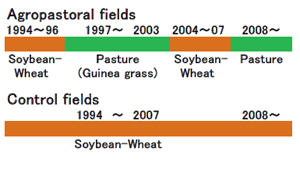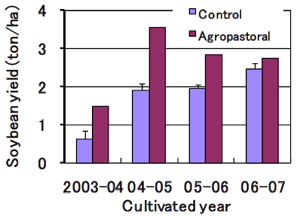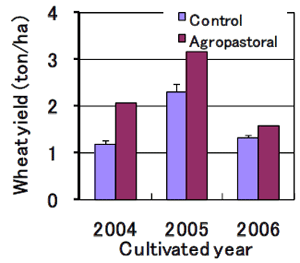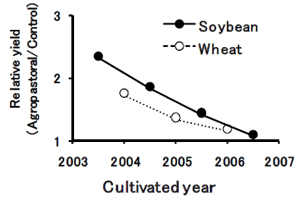Improving the productivity of soybean and wheat by introducing the agropastoral system.
Description
In the tropical savannas of South America, vast areas of croplands were developed during the “Brazilian Cerrado development” in the 1980’s. However, in these croplands, the decrease in the productivity of crops and soil degradation pose a serious problem in long-term continuous cropping. Although the introduction of the agropastoral system is one of the solutions, a quantitative evaluation of the improvement effect on the productivity was not yet conducted. Then, the experimental fields in the continuous cropping fields of the soybean-wheat system in CETAPAR-JICA (Centro Tecnologico Agropecuario en Paraguay-Japan International Cooperation Agency) in Paraguay, which were converted into guinea grass pastures for seven years, were reconverted into cropping fields. We measured the whole yield of soybean and wheat in these fields and control fields (continuous cropping fields) for four years. Furthermore, we analyzed the chemical and physical properties of the soils in both fields, in order to clarify quantitatively the improvement effect on the soybean and wheat productivity and the chemical and physical properties of the soils.
The yields of soybean and wheat of the agropastoral fields were higher than those in the control fields, although their year-to-year variations are large every year (Fig. 2 & 3). Moreover, since the highest yield of the soybean in this area before continuous cropping started to present a problem was about 3 ton/ha, it is deemed that the improvement effect on soybean productivity due to the introduction of the agropastoral system is high. This improvement effect will continue for about four years (Fig. 4). In the continuous cropping field which conducted non-tillage cropping, since phosphate accumulated on the soil surface when the soybean was only able to spread its roots on the surface, the adverse effect which is the decrease of tolerance to drought has become a problem. But, by introducing the agropastoral system, the accumulation of phosphorus and potassium was solved (Table 1). In addition, when the accumulation of soil organic matters was being promoted by the litter and roots of guinea grass, soil aggregation was also improved. From the above results, we can conclude that if an agropastoral system is introduced into any soybean-wheat field in which the overall productivity has been reduced due to continuous cropping, the productivity of soybean and wheat will also be improved with the enhanced physical and chemical properties of the soil due to the effects of the agropastoral use.
Although the investigation was conducted in Paraguay, it is likewise applicable in any tropical savanna area in South America, such as the “cerrados” of Brazil. It is necessary to reconvert the converted soybean-wheat fields into agropastoral fields periodically since the positive agropastoral effects will disappear in about four years.
Figure, table
-
Fig. 1. Cultivation schedule -
Fig. 2. Agropastoral effect on soybean yield
Agropastoral fields (Converted in November, 2003. Total: 3 ha.)
Control fields (Total: 2.1 ha.) -
Fig. 3. Agropastoral effect on wheat yield
Agropastoral fields (Converted in November, 2003. Total: 3 ha.)
Control fields (Total: 2.1 ha.) -
Fig. 4. Year-to-year variations of relative yields of soybean and wheat production
-
Table 1. Chemical and physical properties of the soils in agropastoral and control fields
- Affiliation
-
Japan International Research Center for Agricultural Sciences Animal Production and Grassland Division
- Term of research
-
(FY2004~)FY2006~2008
- Responsible researcher
-
SHIMODA Katsuhisa ( Animal Production and Grassland Division )
HORITA Toshiyuki ( Nikkei-CETAPAR )
HOSHIBA Ken ( Nikkei-CETAPAR )
- ほか
- Publication, etc.
-
Shimoda, K. et al. (2009) Evaluation of an Agropastoral System Introduced into Soybean Fields in Paraguay: Positive Effects on Soybean and Wheat Production. JARQ
Shimoda, K. et al. (2007) Evaluation of effects of an agro-pastoral system on soybean production and soil properties. JIRCAS Working Report 51, 67-71.
- Japanese PDF
-
2008_seikajouhou_A4_ja_Part17.pdf506.75 KB





